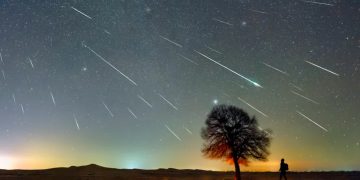THE Moon is set to turn colourful shades of red, pink and even purple over the UK soon, as lunar disk goes through a partial eclipse.
During the eclipse, which occurs in a matter of weeks, almost all of the Moon will be in Earth’s shadow and hidden from the Sun.

The partial lunar eclipse can be observed from the UK on 14 March[/caption]
When the Moon is in full view of the Sun, it shines a brilliant white.
But when it’s in Earth’s shadow – known as the umbra – it takes on an almost “rainbow effect”, Edward Bloomer, senior astronomy manager at the Royal Observatory Greenwich, told The Sun.
“It has stages,” explained Bloomer. “It will first look like a shadow is passing over the lunar surface at first – not totally dark, but darkening the surface.”
He added: “As the Moon moves into the umbra itself (for the most part), the surface will change to be a sort of orangey-browny-red colour.
“Actually, if you take photos and boost the colour you can actually see a reddish sort of rainbow effect as the Moon moves into the umbra – you get pink and purple in there too.”
The partial lunar eclipse can be observed from the UK on 14 March.
On the same day, the US, Canada and South America will be graced with a total lunar eclipse.
People in these areas will enjoy an hour-long Blood Moon, whereas stargazers in the UK will have a distinctly shorter window to gaze at the orange lunar orb.
The UK will experience a total lunar eclipse on 7 September, which will be the last “good, observable total lunar eclipse until the last day of 2028”, according to Bloomer.
While there is a total lunar eclipse due to occur in 2026, the portion of Earth where it will be observable is mostly covered by ocean.
Now if you’re thinking the US get bigger and brighter lunar and solar eclipses than the UK – you’re not wrong.
The UK is geographically shortchanged somewhat, due to its size and height.
“There’s no getting around it I’m afraid,” said Bloomer. “The UK is quite tall but pretty thin, so the East-West rotation of the earth means things like eclipses general slide past us pretty quickly.”
That means the Moon dips under the horizon before it experiences maximum coverage.
He added: “By comparison, the US is a lot wider, so the path of totality for eclipses can trace long corridors across the landmass and be seen by many more people.”

A Supermoon (left) vs a Blood Moon (right)[/caption]
What is a Blood Moon? Lunar eclipses explained
Here's what you need to know…
The Earth is constantly rotating around the Sun, and the Moon is constantly rotating around the Earth.
Sometimes all three can align, placing the Earth directly between the Sun and the Moon in a straight line.
It means the Moon is in the darkest part of Earth’s shadow – the “umbra”.
And due to convenient sizing and distancing of all three objects, no sunlight can directly reach the Moon.
However, some sunlight is refracted by Earth’s atmosphere, making the Moon appear reddish – hence the name “Blood Moon”.
Lunar eclipses typically last just a few hours, and can be viewed from anywhere on the night side of Earth.
Because they’re typically quite dim, it’s also possible to view lunar eclipses without eye protection, which isn’t the case with a solar eclipse.
There are three different types of lunar eclipse:
- Total lunar eclipse – This is where the Moon turns deep red, receiving only light that’s passed through Earth’s atmosphere.
- Penumbral lunar eclipse – This is when the Sun, Moon and Earth fail to form a perfect straight line, so the Moon only travels through the outer part of Earth’s shadow. This means the Moon’s surface is partly darkened.
- Partial lunar eclipse – This is when part of the Moon travels through Earth’s full shadow, which results in part of the Moon being darkened.
Exact time to see
People in the UK will have to keep an eye on their watch as to not miss the upcoming Blood Moon.
Unfortunately, it will fall below the horizon before it experiences maximum coverage, so Brits will only get to see part of the process.
The Moon will first move into Earth’s penumbra – the lighter part of its shadow – at 3.57am GMT.
The peak of the eclipse in London will be at 6.19am GMT – so prepare for an early rise on the morning of the 14 March.
That being said, the actual maximum of the eclipse will occur at 6.58am GMT – however, the Moon will have set below the horizon by then.
To view the Blood Moon, you’ll want to find a high point with a clear view of the western sky.
This will allow you to see more of the eclipse.

People in the UK will have to keep an eye on their watch as to not miss the upcoming Blood Moon[/caption]
All you need to know about planets in our solar system
Our solar system is made up of nine planets with Earth the third closest to the Sun. But each planet has its own quirks, so find out more about them all…
- How old is Earth? Plus other facts on our planet
- How many moons does Mercury have?
- What colour is Venus?
- How far away is Mars to Earth? And other facts on the red planet
- How big is Jupiter?
- How many moons does Saturn have?
- Does Uranus have rings?
- How many moons does Neptune have?
- How big is Pluto?
- How hot is the Sun?
Unlock even more award-winning articles as The Sun launches brand new membership programme – Sun Club



























